Solved: Quantitative Methods in Finance University Assignment
VerifiedAdded on 2023/06/08
|15
|1289
|491
Homework Assignment
AI Summary
This assignment solution covers various quantitative methods applied in finance. It includes calculations for absolute and relative changes in time series data, average discrete and continuous monthly returns, and solving quadratic equations using discriminant analysis and Excel Solver. The assignment also addresses calculus problems involving derivatives and integration, along with linear and quadratic approximations of functions. Furthermore, it delves into present value calculations, bond valuation, and portfolio construction, providing detailed steps and explanations for each problem. The solutions are supported by graphs and tables generated using Excel, illustrating the application of these methods in financial analysis.
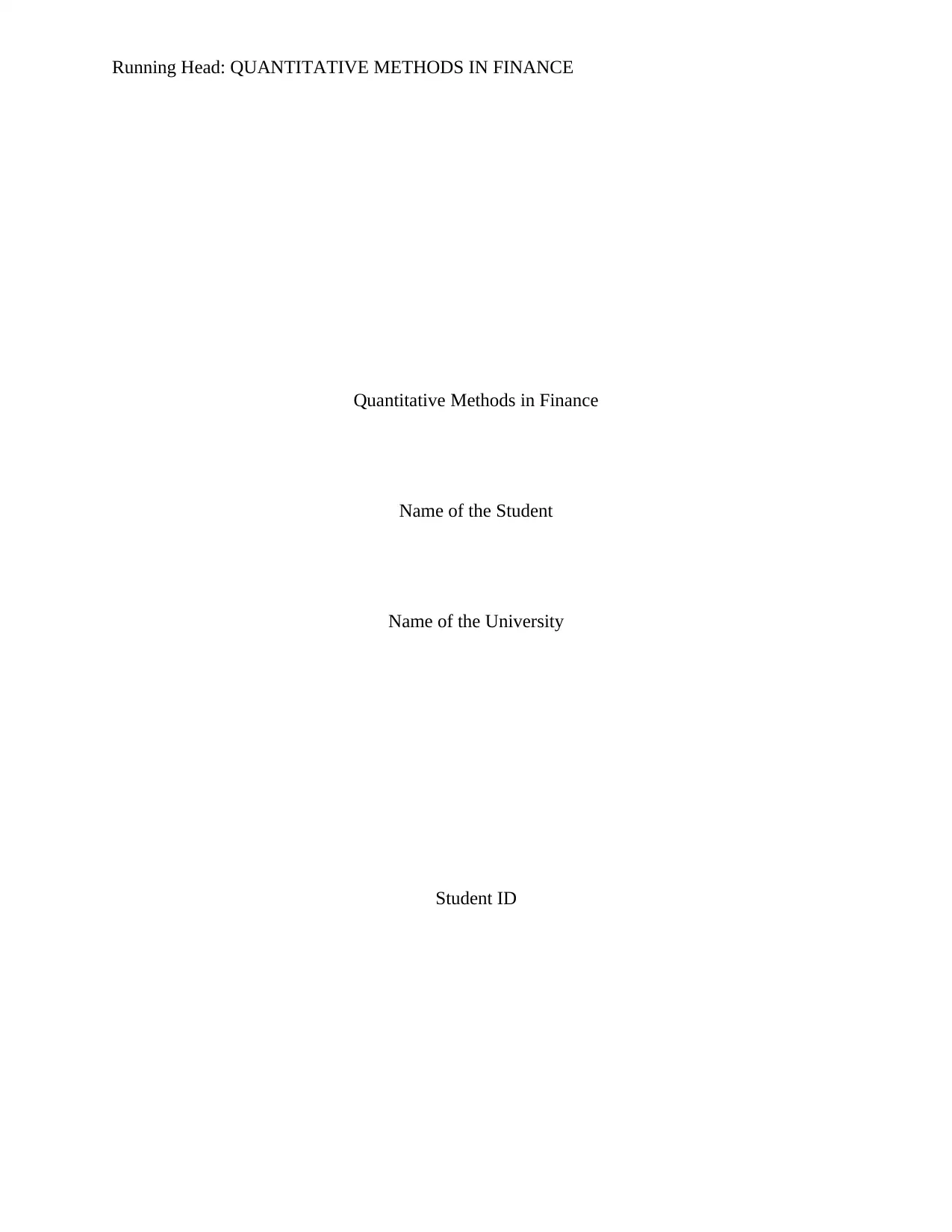
Running Head: QUANTITATIVE METHODS IN FINANCE
Quantitative Methods in Finance
Name of the Student
Name of the University
Student ID
Quantitative Methods in Finance
Name of the Student
Name of the University
Student ID
Paraphrase This Document
Need a fresh take? Get an instant paraphrase of this document with our AI Paraphraser
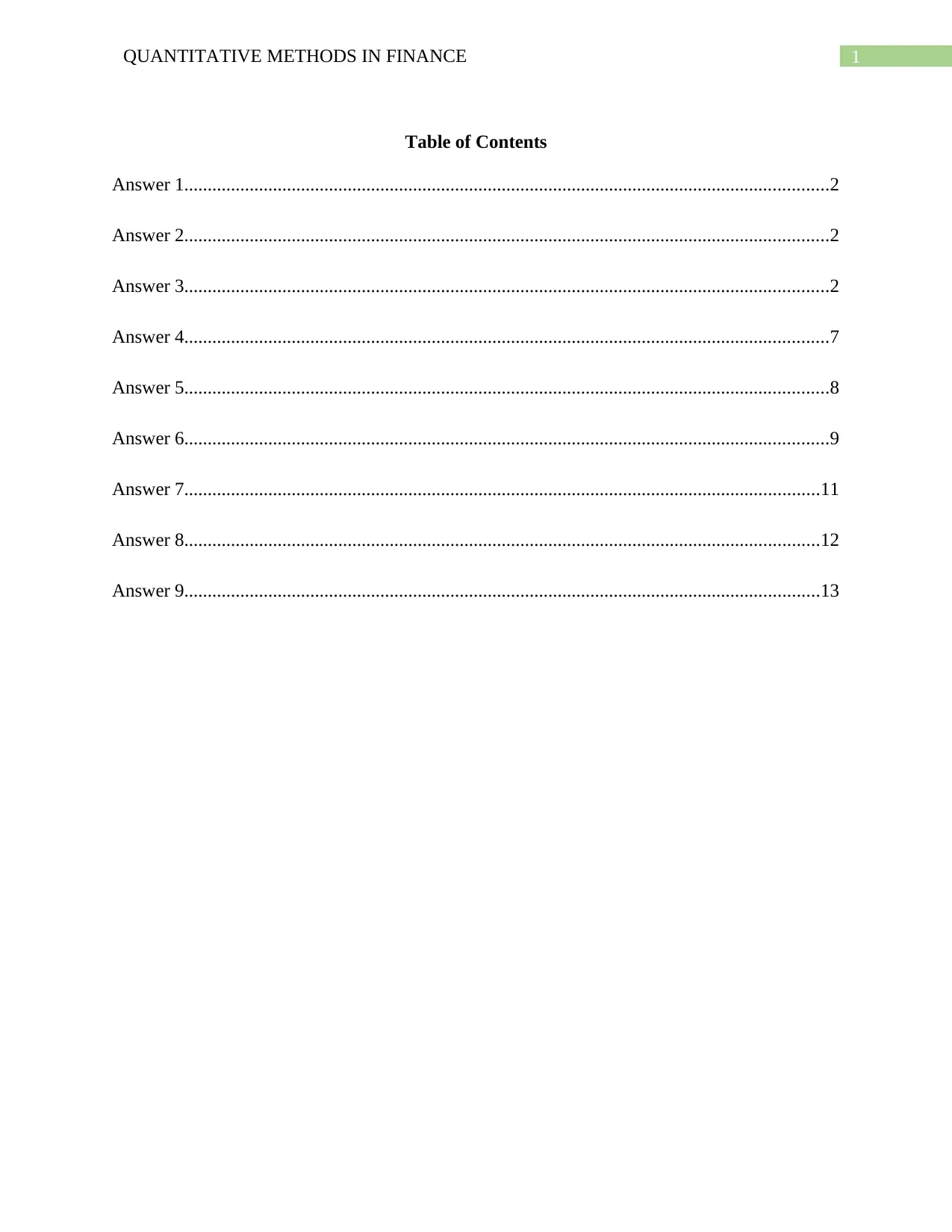
1QUANTITATIVE METHODS IN FINANCE
Table of Contents
Answer 1..........................................................................................................................................2
Answer 2..........................................................................................................................................2
Answer 3..........................................................................................................................................2
Answer 4..........................................................................................................................................7
Answer 5..........................................................................................................................................8
Answer 6..........................................................................................................................................9
Answer 7........................................................................................................................................11
Answer 8........................................................................................................................................12
Answer 9........................................................................................................................................13
Table of Contents
Answer 1..........................................................................................................................................2
Answer 2..........................................................................................................................................2
Answer 3..........................................................................................................................................2
Answer 4..........................................................................................................................................7
Answer 5..........................................................................................................................................8
Answer 6..........................................................................................................................................9
Answer 7........................................................................................................................................11
Answer 8........................................................................................................................................12
Answer 9........................................................................................................................................13
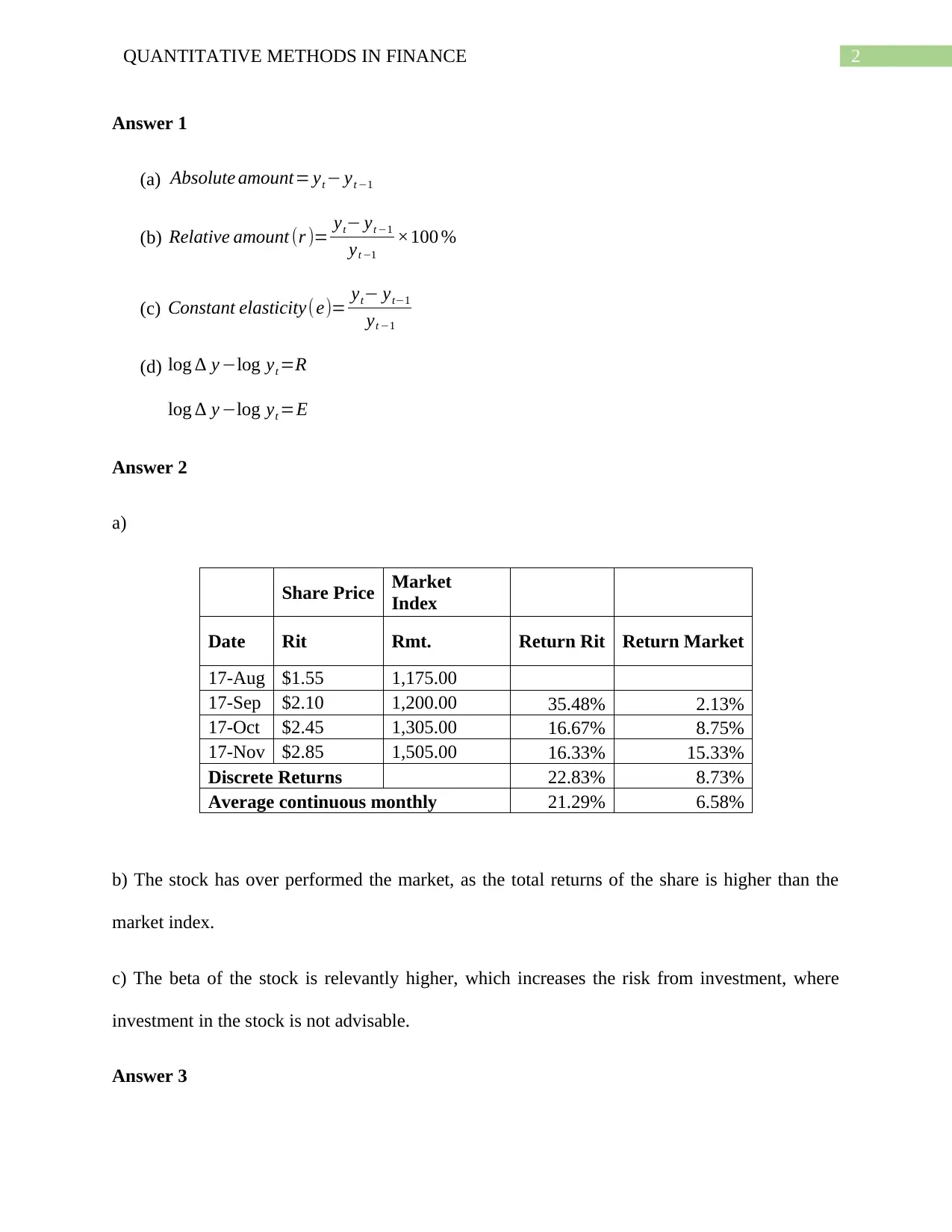
2QUANTITATIVE METHODS IN FINANCE
Answer 1
(a) Absolute amount= yt − yt −1
(b) Relative amount (r )= yt− yt −1
yt −1
×100 %
(c) Constant elasticity(e)= yt− yt−1
yt −1
(d) log ∆ y −log yt =R
log ∆ y −log yt =E
Answer 2
a)
Share Price Market
Index
Date Rit Rmt. Return Rit Return Market
17-Aug $1.55 1,175.00
17-Sep $2.10 1,200.00 35.48% 2.13%
17-Oct $2.45 1,305.00 16.67% 8.75%
17-Nov $2.85 1,505.00 16.33% 15.33%
Discrete Returns 22.83% 8.73%
Average continuous monthly 21.29% 6.58%
b) The stock has over performed the market, as the total returns of the share is higher than the
market index.
c) The beta of the stock is relevantly higher, which increases the risk from investment, where
investment in the stock is not advisable.
Answer 3
Answer 1
(a) Absolute amount= yt − yt −1
(b) Relative amount (r )= yt− yt −1
yt −1
×100 %
(c) Constant elasticity(e)= yt− yt−1
yt −1
(d) log ∆ y −log yt =R
log ∆ y −log yt =E
Answer 2
a)
Share Price Market
Index
Date Rit Rmt. Return Rit Return Market
17-Aug $1.55 1,175.00
17-Sep $2.10 1,200.00 35.48% 2.13%
17-Oct $2.45 1,305.00 16.67% 8.75%
17-Nov $2.85 1,505.00 16.33% 15.33%
Discrete Returns 22.83% 8.73%
Average continuous monthly 21.29% 6.58%
b) The stock has over performed the market, as the total returns of the share is higher than the
market index.
c) The beta of the stock is relevantly higher, which increases the risk from investment, where
investment in the stock is not advisable.
Answer 3
⊘ This is a preview!⊘
Do you want full access?
Subscribe today to unlock all pages.

Trusted by 1+ million students worldwide
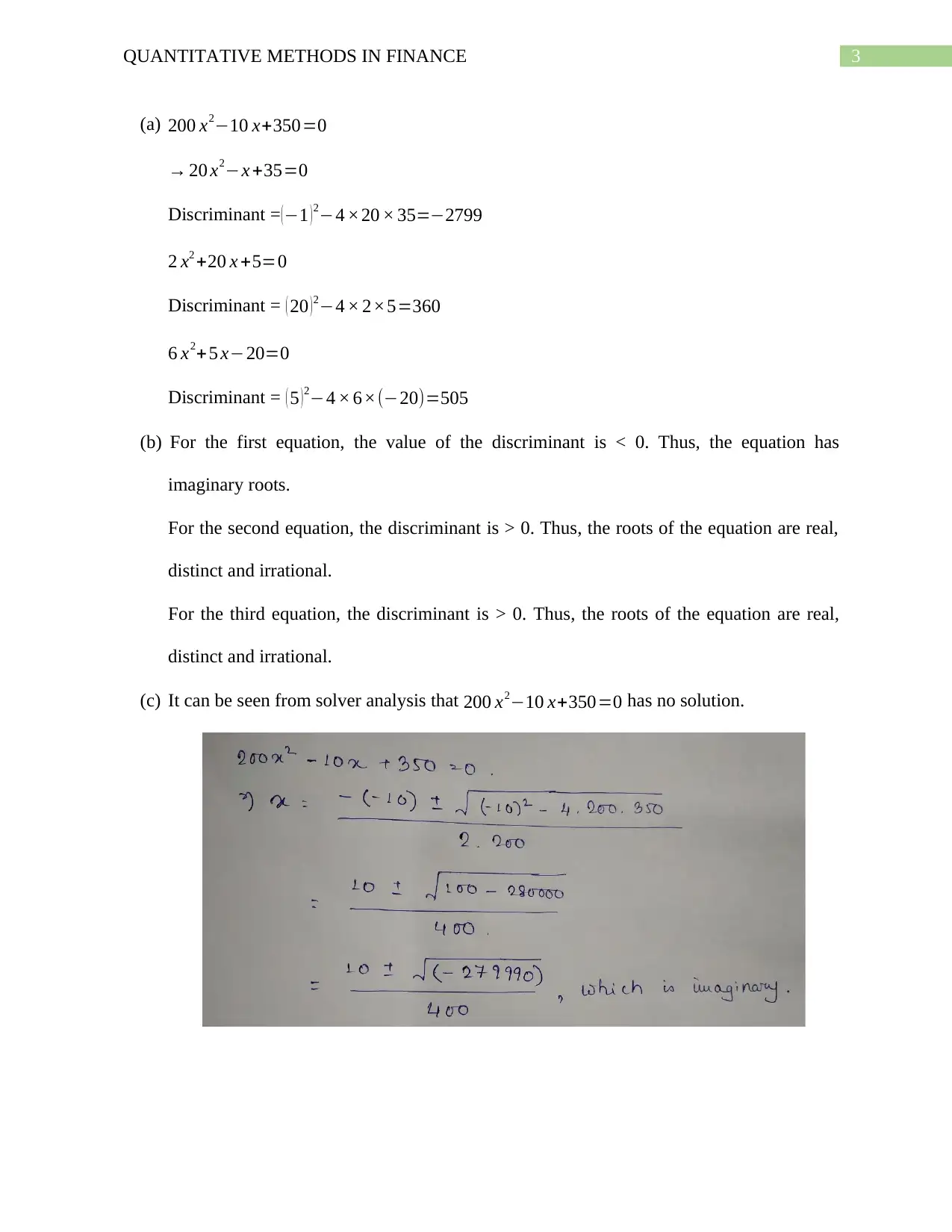
3QUANTITATIVE METHODS IN FINANCE
(a) 200 x2−10 x+350=0
→ 20 x2−x +35=0
Discriminant =( −1 ) 2−4 ×20 × 35=−2799
2 x2 +20 x +5=0
Discriminant = ( 20 ) 2−4 × 2×5=360
6 x2+5 x−20=0
Discriminant = ( 5 ) 2−4 × 6×(−20)=505
(b) For the first equation, the value of the discriminant is < 0. Thus, the equation has
imaginary roots.
For the second equation, the discriminant is > 0. Thus, the roots of the equation are real,
distinct and irrational.
For the third equation, the discriminant is > 0. Thus, the roots of the equation are real,
distinct and irrational.
(c) It can be seen from solver analysis that 200 x2−10 x+350=0 has no solution.
(a) 200 x2−10 x+350=0
→ 20 x2−x +35=0
Discriminant =( −1 ) 2−4 ×20 × 35=−2799
2 x2 +20 x +5=0
Discriminant = ( 20 ) 2−4 × 2×5=360
6 x2+5 x−20=0
Discriminant = ( 5 ) 2−4 × 6×(−20)=505
(b) For the first equation, the value of the discriminant is < 0. Thus, the equation has
imaginary roots.
For the second equation, the discriminant is > 0. Thus, the roots of the equation are real,
distinct and irrational.
For the third equation, the discriminant is > 0. Thus, the roots of the equation are real,
distinct and irrational.
(c) It can be seen from solver analysis that 200 x2−10 x+350=0 has no solution.
Paraphrase This Document
Need a fresh take? Get an instant paraphrase of this document with our AI Paraphraser
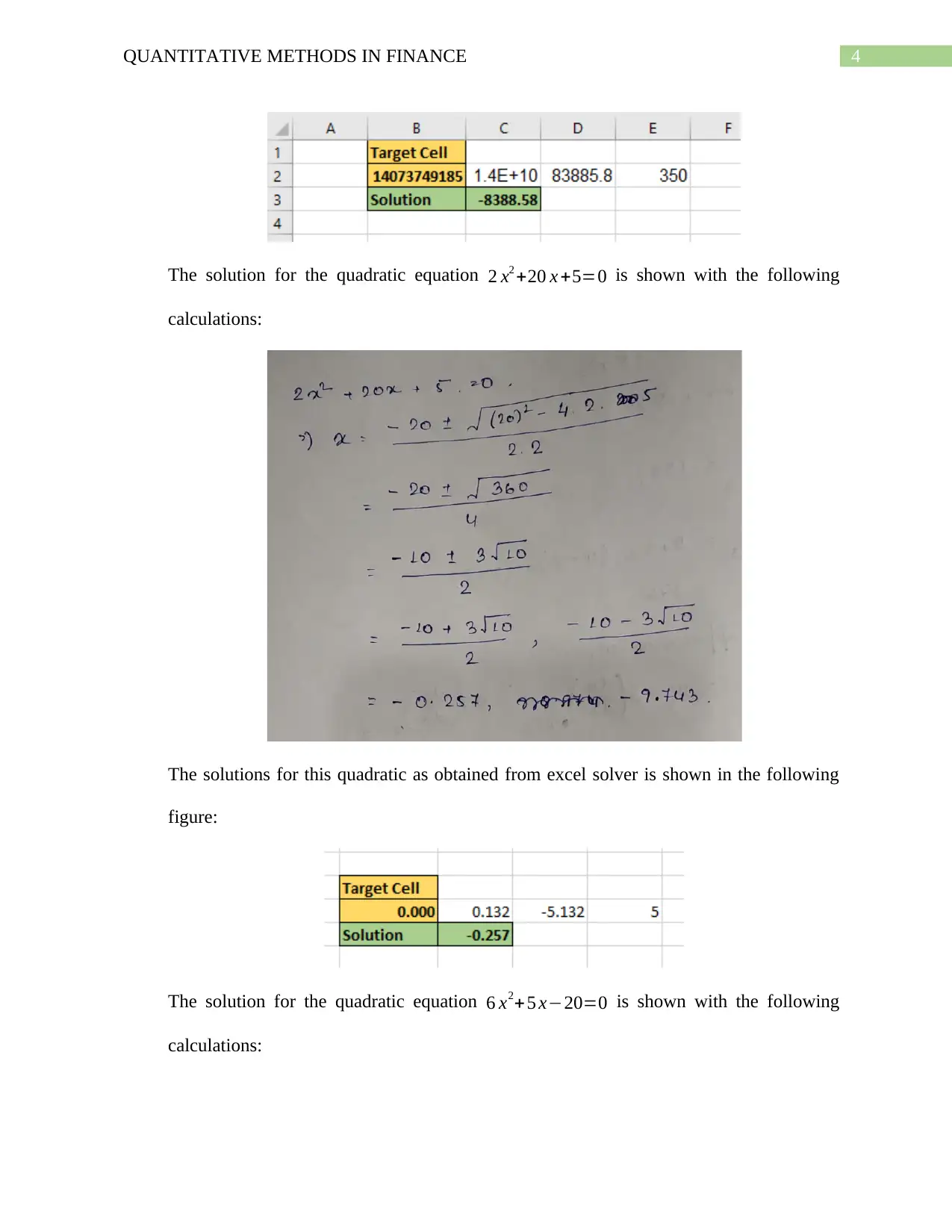
4QUANTITATIVE METHODS IN FINANCE
The solution for the quadratic equation 2 x2 +20 x +5=0 is shown with the following
calculations:
The solutions for this quadratic as obtained from excel solver is shown in the following
figure:
The solution for the quadratic equation 6 x2+ 5 x−20=0 is shown with the following
calculations:
The solution for the quadratic equation 2 x2 +20 x +5=0 is shown with the following
calculations:
The solutions for this quadratic as obtained from excel solver is shown in the following
figure:
The solution for the quadratic equation 6 x2+ 5 x−20=0 is shown with the following
calculations:
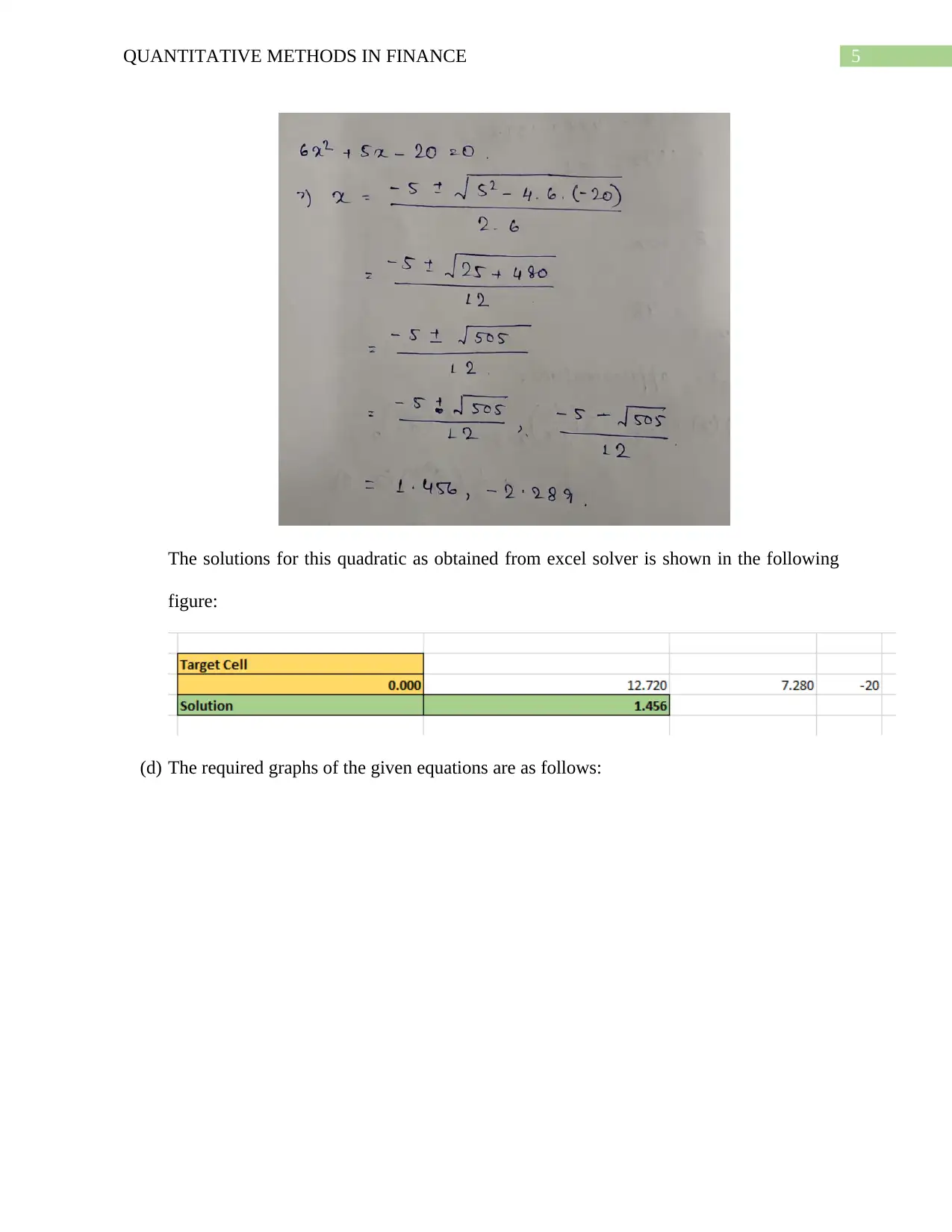
5QUANTITATIVE METHODS IN FINANCE
The solutions for this quadratic as obtained from excel solver is shown in the following
figure:
(d) The required graphs of the given equations are as follows:
The solutions for this quadratic as obtained from excel solver is shown in the following
figure:
(d) The required graphs of the given equations are as follows:
⊘ This is a preview!⊘
Do you want full access?
Subscribe today to unlock all pages.

Trusted by 1+ million students worldwide
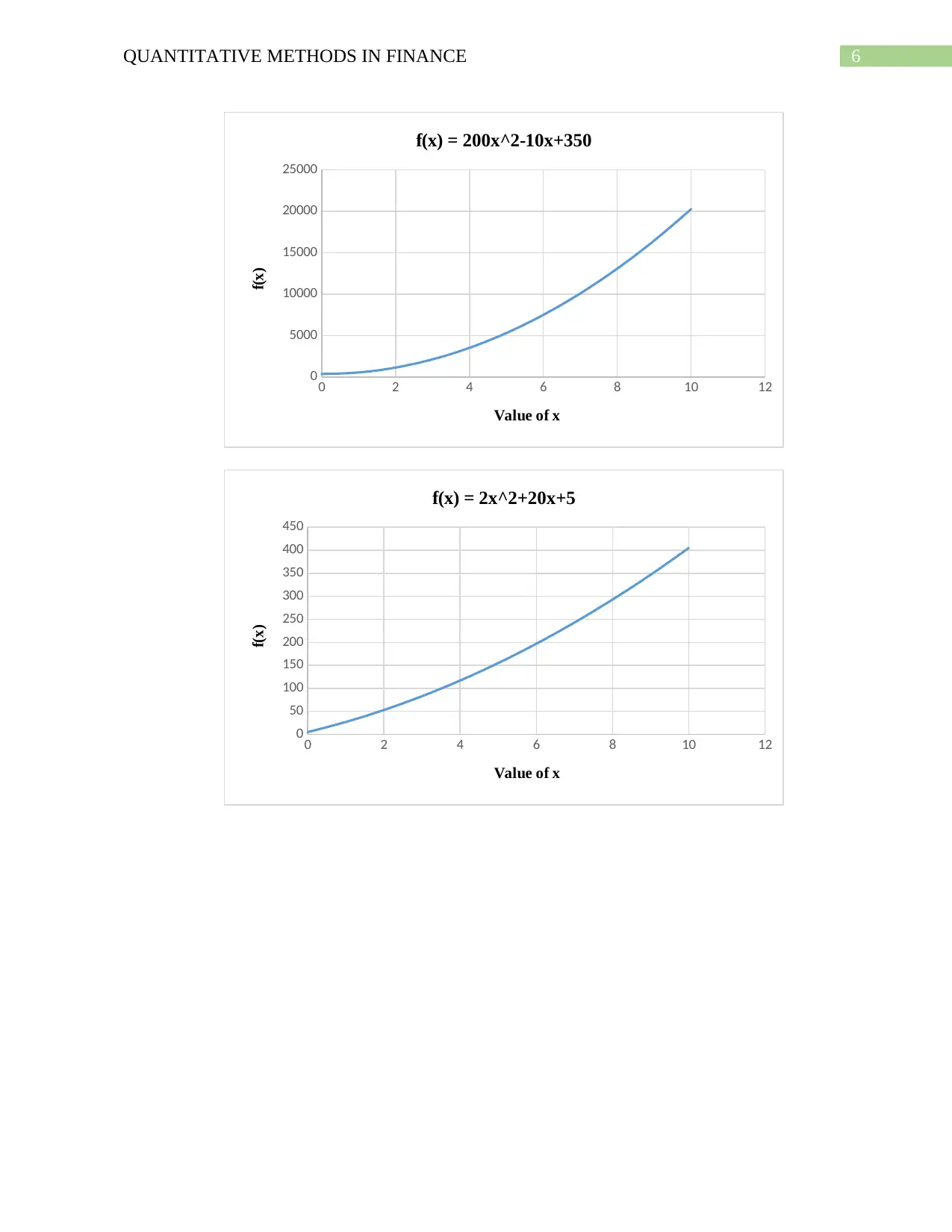
6QUANTITATIVE METHODS IN FINANCE
0 2 4 6 8 10 12
0
5000
10000
15000
20000
25000
f(x) = 200x^2-10x+350
Value of x
f(x)
0 2 4 6 8 10 12
0
50
100
150
200
250
300
350
400
450
f(x) = 2x^2+20x+5
Value of x
f(x)
0 2 4 6 8 10 12
0
5000
10000
15000
20000
25000
f(x) = 200x^2-10x+350
Value of x
f(x)
0 2 4 6 8 10 12
0
50
100
150
200
250
300
350
400
450
f(x) = 2x^2+20x+5
Value of x
f(x)
Paraphrase This Document
Need a fresh take? Get an instant paraphrase of this document with our AI Paraphraser
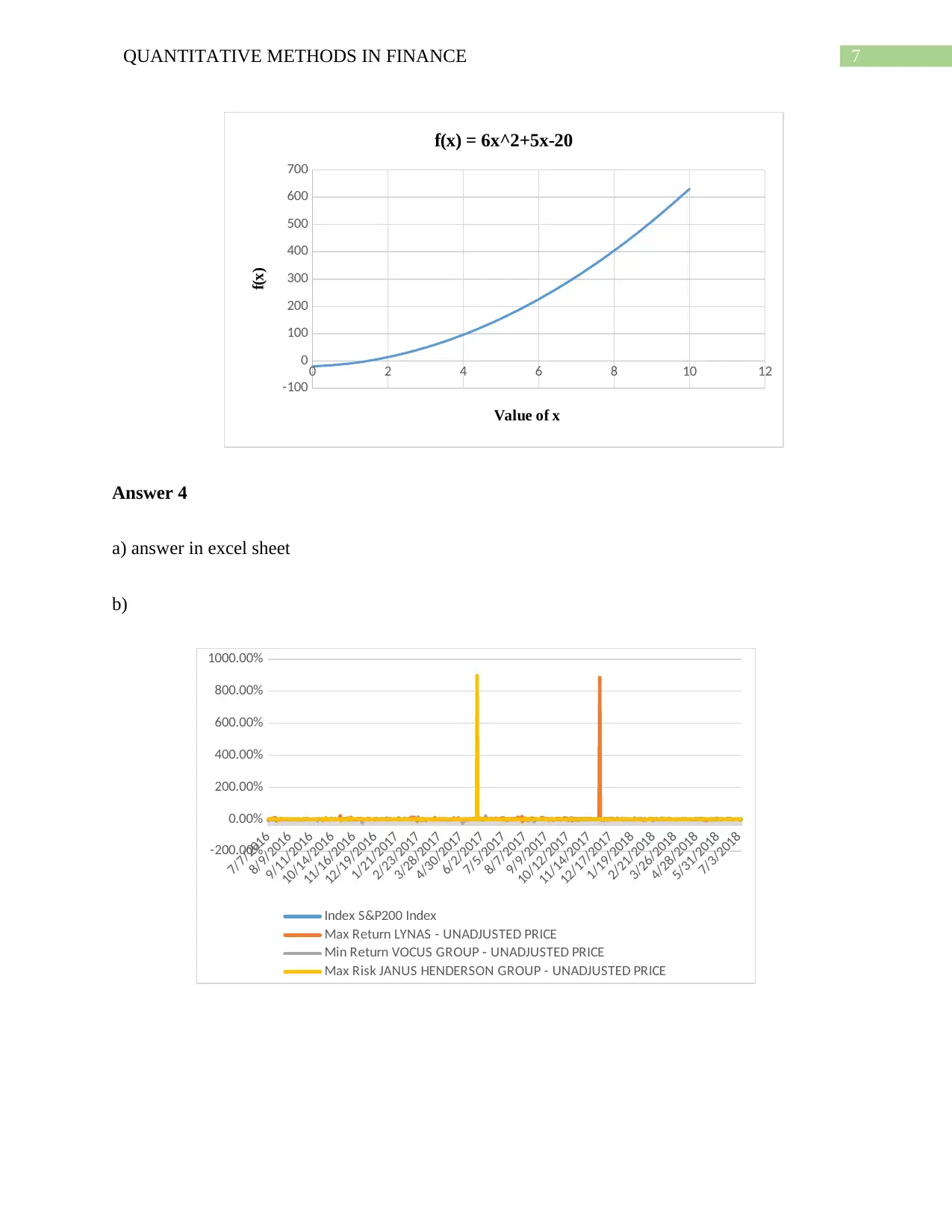
7QUANTITATIVE METHODS IN FINANCE
0 2 4 6 8 10 12
-100
0
100
200
300
400
500
600
700
f(x) = 6x^2+5x-20
Value of x
f(x)
Answer 4
a) answer in excel sheet
b)
7/7/2016
8/9/2016
9/11/2016
10/14/2016
11/16/2016
12/19/2016
1/21/2017
2/23/2017
3/28/2017
4/30/2017
6/2/2017
7/5/2017
8/7/2017
9/9/2017
10/12/2017
11/14/2017
12/17/2017
1/19/2018
2/21/2018
3/26/2018
4/28/2018
5/31/2018
7/3/2018
-200.00%
0.00%
200.00%
400.00%
600.00%
800.00%
1000.00%
Index S&P200 Index
Max Return LYNAS - UNADJUSTED PRICE
Min Return VOCUS GROUP - UNADJUSTED PRICE
Max Risk JANUS HENDERSON GROUP - UNADJUSTED PRICE
0 2 4 6 8 10 12
-100
0
100
200
300
400
500
600
700
f(x) = 6x^2+5x-20
Value of x
f(x)
Answer 4
a) answer in excel sheet
b)
7/7/2016
8/9/2016
9/11/2016
10/14/2016
11/16/2016
12/19/2016
1/21/2017
2/23/2017
3/28/2017
4/30/2017
6/2/2017
7/5/2017
8/7/2017
9/9/2017
10/12/2017
11/14/2017
12/17/2017
1/19/2018
2/21/2018
3/26/2018
4/28/2018
5/31/2018
7/3/2018
-200.00%
0.00%
200.00%
400.00%
600.00%
800.00%
1000.00%
Index S&P200 Index
Max Return LYNAS - UNADJUSTED PRICE
Min Return VOCUS GROUP - UNADJUSTED PRICE
Max Risk JANUS HENDERSON GROUP - UNADJUSTED PRICE
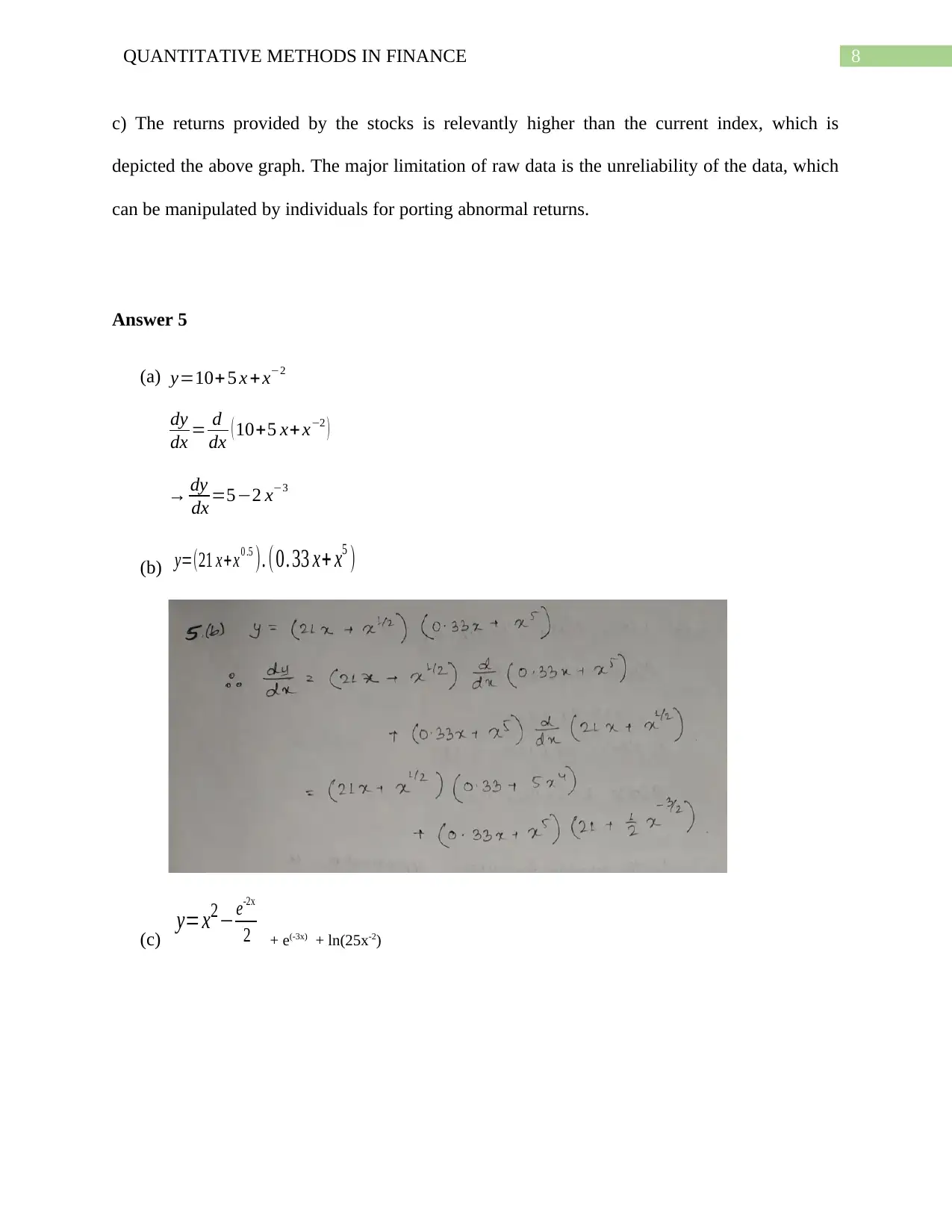
8QUANTITATIVE METHODS IN FINANCE
c) The returns provided by the stocks is relevantly higher than the current index, which is
depicted the above graph. The major limitation of raw data is the unreliability of the data, which
can be manipulated by individuals for porting abnormal returns.
Answer 5
(a) y=10+ 5 x +x−2
dy
dx = d
dx ( 10+5 x+ x−2 )
→ dy
dx =5−2 x−3
(b) y=(21 x+x0 .5 ). (0. 33 x+ x5 )
(c) y= x2− e-2x
2 + e(-3x) + ln(25x-2)
c) The returns provided by the stocks is relevantly higher than the current index, which is
depicted the above graph. The major limitation of raw data is the unreliability of the data, which
can be manipulated by individuals for porting abnormal returns.
Answer 5
(a) y=10+ 5 x +x−2
dy
dx = d
dx ( 10+5 x+ x−2 )
→ dy
dx =5−2 x−3
(b) y=(21 x+x0 .5 ). (0. 33 x+ x5 )
(c) y= x2− e-2x
2 + e(-3x) + ln(25x-2)
⊘ This is a preview!⊘
Do you want full access?
Subscribe today to unlock all pages.

Trusted by 1+ million students worldwide
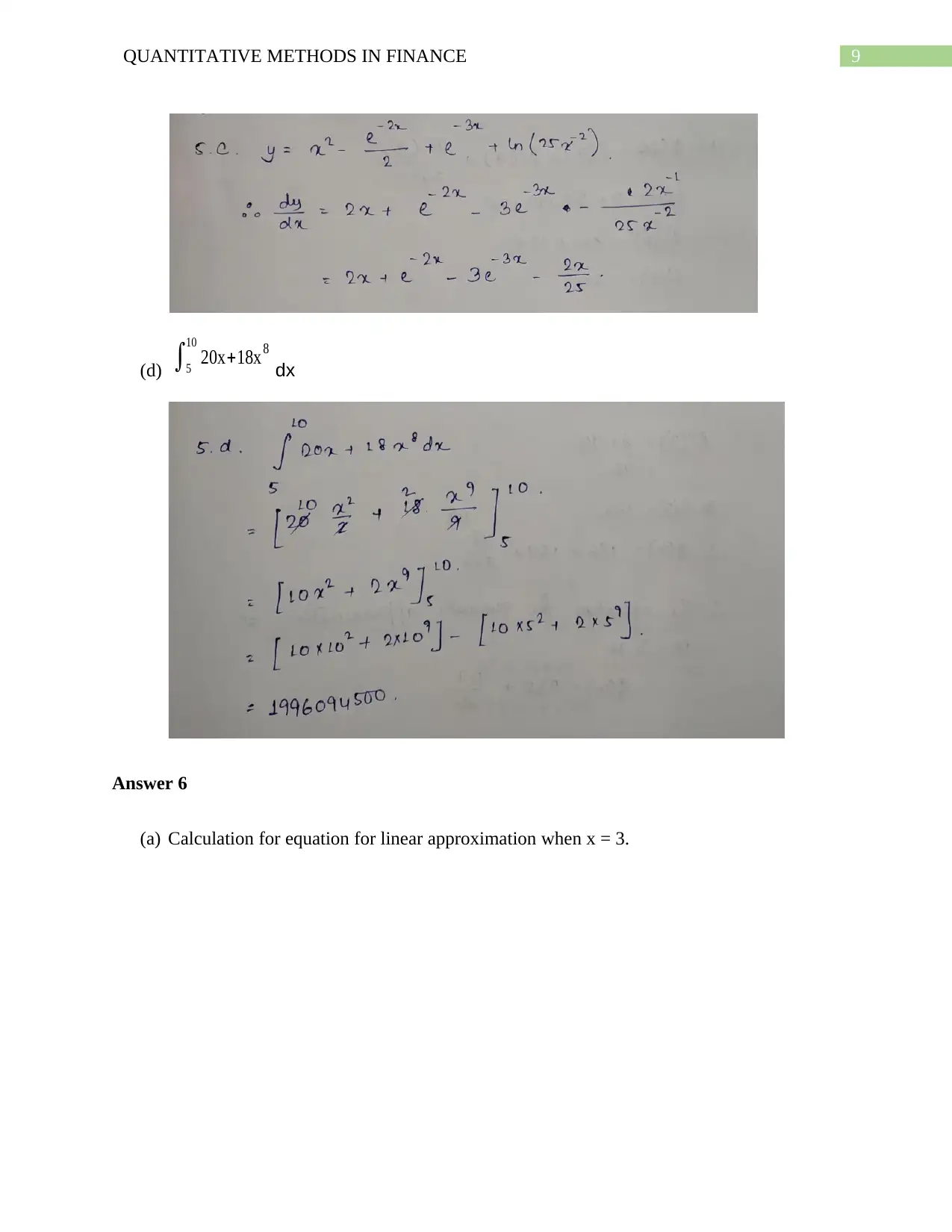
9QUANTITATIVE METHODS IN FINANCE
(d) ∫5
10
20x+18x8
dx
Answer 6
(a) Calculation for equation for linear approximation when x = 3.
(d) ∫5
10
20x+18x8
dx
Answer 6
(a) Calculation for equation for linear approximation when x = 3.
Paraphrase This Document
Need a fresh take? Get an instant paraphrase of this document with our AI Paraphraser
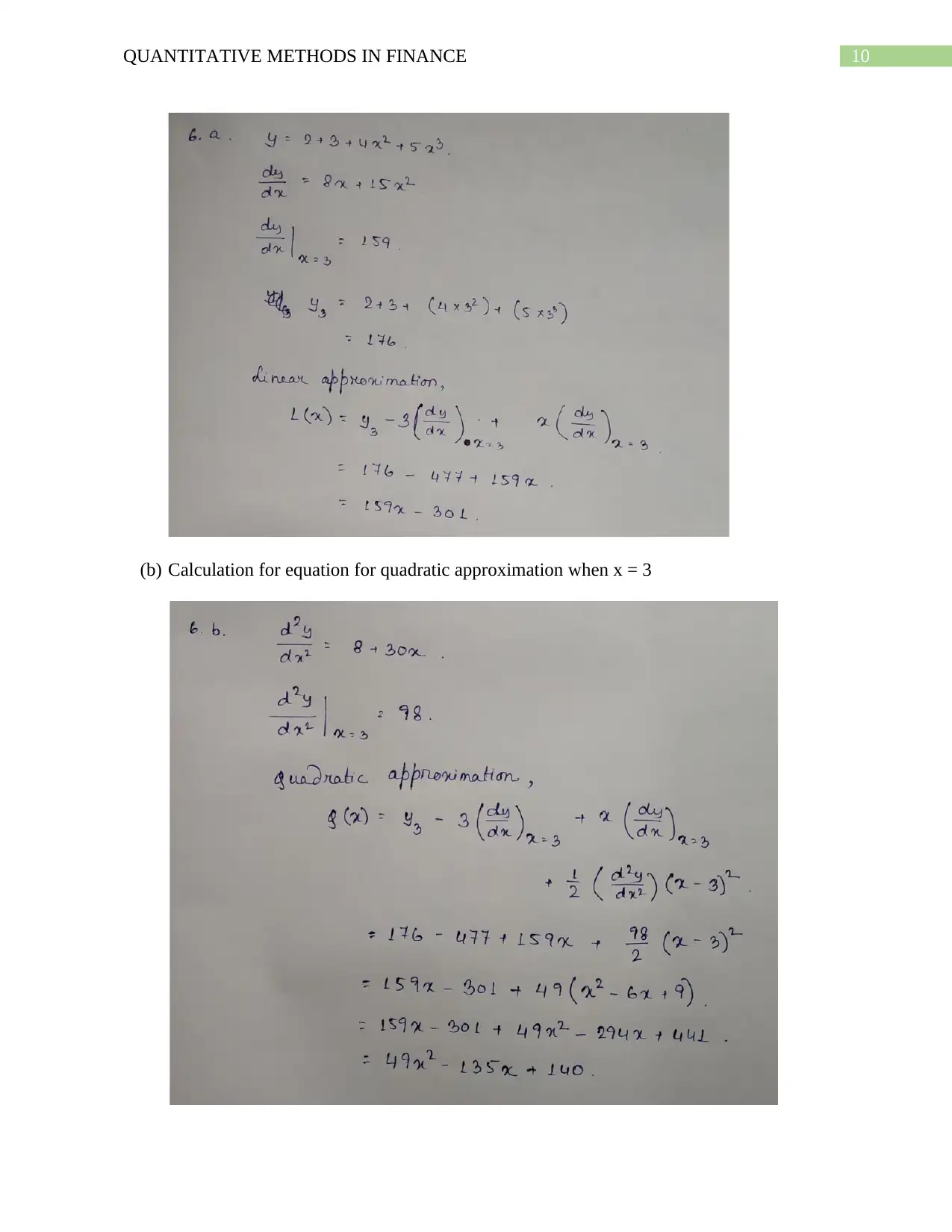
10QUANTITATIVE METHODS IN FINANCE
(b) Calculation for equation for quadratic approximation when x = 3
(b) Calculation for equation for quadratic approximation when x = 3
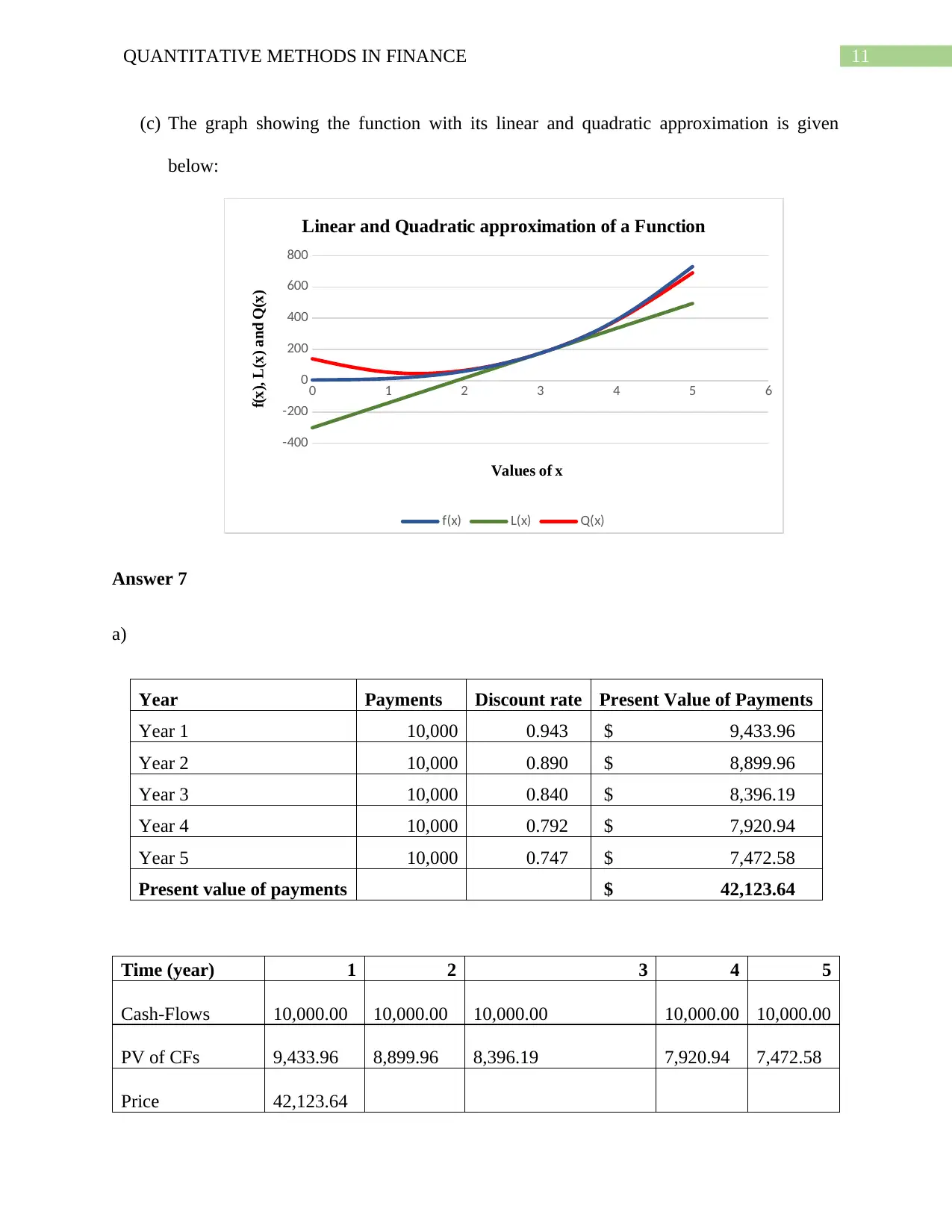
11QUANTITATIVE METHODS IN FINANCE
(c) The graph showing the function with its linear and quadratic approximation is given
below:
0 1 2 3 4 5 6
-400
-200
0
200
400
600
800
Linear and Quadratic approximation of a Function
f(x) L(x) Q(x)
Values of x
f(x), L(x) and Q(x)
Answer 7
a)
Year Payments Discount rate Present Value of Payments
Year 1 10,000 0.943 $ 9,433.96
Year 2 10,000 0.890 $ 8,899.96
Year 3 10,000 0.840 $ 8,396.19
Year 4 10,000 0.792 $ 7,920.94
Year 5 10,000 0.747 $ 7,472.58
Present value of payments $ 42,123.64
Time (year) 1 2 3 4 5
Cash-Flows 10,000.00 10,000.00 10,000.00 10,000.00 10,000.00
PV of CFs 9,433.96 8,899.96 8,396.19 7,920.94 7,472.58
Price 42,123.64
(c) The graph showing the function with its linear and quadratic approximation is given
below:
0 1 2 3 4 5 6
-400
-200
0
200
400
600
800
Linear and Quadratic approximation of a Function
f(x) L(x) Q(x)
Values of x
f(x), L(x) and Q(x)
Answer 7
a)
Year Payments Discount rate Present Value of Payments
Year 1 10,000 0.943 $ 9,433.96
Year 2 10,000 0.890 $ 8,899.96
Year 3 10,000 0.840 $ 8,396.19
Year 4 10,000 0.792 $ 7,920.94
Year 5 10,000 0.747 $ 7,472.58
Present value of payments $ 42,123.64
Time (year) 1 2 3 4 5
Cash-Flows 10,000.00 10,000.00 10,000.00 10,000.00 10,000.00
PV of CFs 9,433.96 8,899.96 8,396.19 7,920.94 7,472.58
Price 42,123.64
⊘ This is a preview!⊘
Do you want full access?
Subscribe today to unlock all pages.

Trusted by 1+ million students worldwide
1 out of 15
Related Documents
Your All-in-One AI-Powered Toolkit for Academic Success.
+13062052269
info@desklib.com
Available 24*7 on WhatsApp / Email
![[object Object]](/_next/static/media/star-bottom.7253800d.svg)
Unlock your academic potential
Copyright © 2020–2025 A2Z Services. All Rights Reserved. Developed and managed by ZUCOL.




